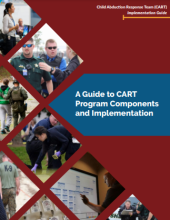Training
A Spatial Analysis of Mental Health-related Calls for Service in Atlantic City, New Jersey
Child Abduction Response Team (CART) Certification Guide: A Guide for Agencies and CART Programs Pursuing Certification
Child Abduction Response Team (CART) Implementation Guide: A Guide to CART Program Components and Implementation
Assessing the Fit Between U.S. Sponsored Training and the Needs of Ukrainian Police Agencies
Coordinated Strangulation Incident Response Training for Law Enforcement Officers and Emergency Medical Personnel Lesson Plan
Coordinated Strangulation Incident Response Training for Law Enforcement Officers and Emergency Medical Personnel
Extinction Training Suppresses Activity of Fear Memory Ensembles across the Hippocampus and Alters Transcriptomes of Fear-encoding Cells
Improved Officer Decision-Making and Stress Management with Virtual Environments
Coordinated Strangulation Incident Response Training for Law Enforcement Officers and Emergency Medical Personnel
Family Skills Training Programs for Family Drug Court
State and Local Law Enforcement Training Academies and Recruits, 2022 – Statistical Tables
Strategies and Training to Advance Greater Elder Safety (STAGES) Pilot Curriculum
Redesigning Life in U.S. Prisons
The prison system in the U.S. typically places a heavy emphasis on security, control, and punishment, and this foundation can create an adversarial culture within correctional facilities — incarcerated individuals versus correctional staff. But what if that culture could change? What would it look like? How would it impact not only incarcerated individuals but also correctional officers and other staff?










